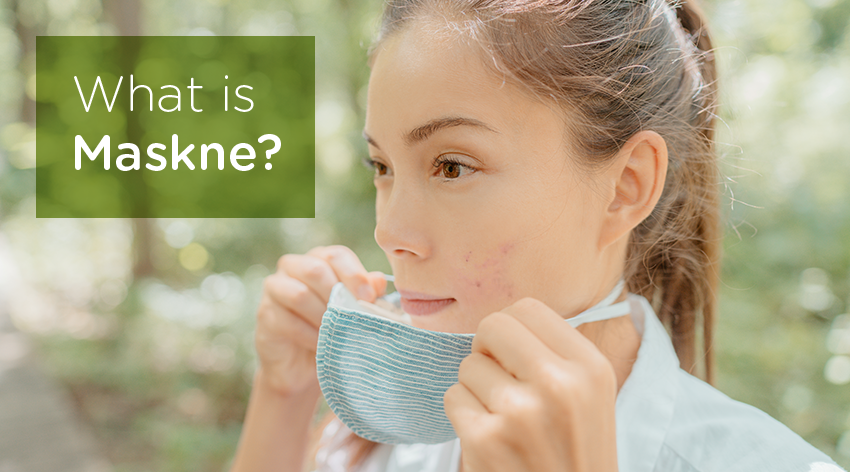
What is Maskne …. and How Do You Get Rid of It?!
This year has brought a multitude of changes to pretty much every aspect of our lives, one of which is the frequent wearing of masks to protect yourself and others. While for some it may just mean wearing a mask for a couple of hours for a trip to the grocery store, for others – including front line workers and teachers – it is hours upon hours of mask wearing that is wreaking havoc on our skin.
“Maskne” is the term that has been given to the acne and irritation that results from the wearing of a facial covering. Masks can both create new skin issues and worsen issues that already exist.
What Causes Maskne?
The wearing of a tight-fitting mask on your face prohibits air flow, resulting in a warm, moist environment that is ideal for skin bacteria to flourish. As the bacteria grows it blocks pores causing whiteheads, blackheads, and painful pimples. Maskne can also be caused by the repetitive rubbing of the mask on your face. Typically, areas on the face such as the bridge of the nose, sides of the cheeks, and the chin are most irritated by this type of maskne.
What Type of Mask is Best to Avoid Maskne?
The type of mask you wear and how it fits will determine its impact on your skin. You must consider the type of mask you wear and balance the weight of the mask material with the level of protection that it will give you. Generally speaking, a mask made of multiple layers of 100% cotton are best because it allows the skin to breathe. Be careful not to wear a mask too tightly as that will drastically increase the amount of sweat and bacteria building up. Conversely, a mask that is too loose will cause friction and irritate the skin.
According to Emilia Hanson, FNP-C, “If your skin is super sensitive or you have inflammatory skin concerns such as Rosacea the material of the mask is important- you want soft, breathable fabric that will not scratch or rub too much causing more inflammation.” And don’t forget to wash your mask daily, or change your disposable mask frequently.
What’s the Best Skincare Routine for Maskne?
Simply put, less is more right now. Be sure to clean your face with a gentle cleanser and add in a good moisturizer that will both moisturize your face and protect it from mask friction. You should cleanse your face both before you put on your mask as well as immediately after taking it off.
“HA5 can be used morning and night and is perfect for targeting anti-inflammatory properties and hydration. This is a great product to keep skin healthy and reduce breakouts,” explains Timeless clinician, Jessica Ropp, FNP-C.
As you decide what other skincare products to use, consider that masks will intensify product delivery, which isn’t necessarily a good thing when it comes to natural irritants like acids and retinols. If you are already using a retinol product, you may want to consider using only at night or reducing usage. If you have “naive skin,” having never used retinol, now is probably not the time to start.
And remember when we said less is more? That especially applies to makeup! Emilia says, “No makeup. Play up the eyes and that is fine, but little to no makeup. The skin is struggling to breathe under the mask and makeup just makes worse.” If you really feel like you need a little something, use a tinted moisturizer with sunscreen.
How Do You Treat Maskne?
It’s important to remember that acne treatments can be irritating in and of themselves, so when dealing with maskne you need to address the acne while also dealing with the irritation of the mask.
To address spot treatments of acne, Dr. Carol Clinton recommends an over-the-counter benzoyl peroxide of 2.5% or 5.0%, a sulphur product, or alpha or beta hydroxy acid products. If you are already using retinol, you may want to alternate that product one night with the spot treatment the next.
Exfoliating and toner can also help to prevent and treat maskne. “I love SkinMedica’s AHA/ BHA cleanser and Obagi’s toner, says Emilia. “Both will help the tissue find a more “harmonious” balance with the mask- or as harmonious as possible!!”
You also may want to consider that you are not dealing with just acne from your mask. If it looks like a rash or is very itchy, it’s possible that it is contact dermatitis. This is often caused by the friction of the mask rather than bacteria growth. Dr. Clinton suggests Aquaphor or Vaseline to help with dryness, and hydrocortisone cream may help if it is more severe. But because hydrocortisone can actually cause a flare up of acne, check with your clinician or physician before taking this approach.
What Skincare Treatments Can Help Address Maskne?
If you want to take your maskne treatment a little further, consider a few of the treatments offered at Timeless Skin Solutions, including Diamond Glow, Dermaplane, and a Chemical Peel.
Jessica Ropp encourages her patients to do a combination of treatments for the best results. “I recommend Diamond Glow with a chemical peel add-on.” She explains, “Diamond Glow will leave your skin feeling refreshed by providing a deeper exfoliation, while targeting the primary concerns (acne) using a medical grade solution. Adding a chemical peel will produce a synergistic effect by increasing cellular turnover and targeting acne further.”
The physicians and clinicians at Timeless can help you navigate this new obstacle in your skincare journey and create a plan to keep your skin healthy, comfortable, and radiant. Contact us to set up your consultation.
